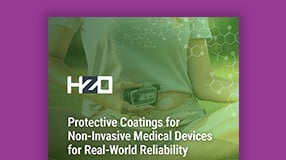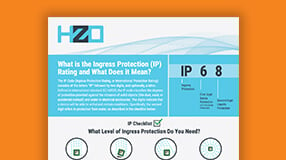Improving CGM Electronics Designs with Medical Coatings

A vital issue for continuous glucose monitor development is design and reliability engineering.
CGM systems, however, will encounter environments that can jeopardize electronics that enable functions, such as sensors, making validation of actual product use difficult. The human body will subject CGMs to perspiration and other bodily fluids, vibration, shock, and the potential for drops.
Additionally, regular use presents threats in varied environments as users always wear the products in various settings. CGM devices are more valued by people with diabetes when they enable ease of use. Using continuous glucose monitoring systems in showers, harsh weather conditions, swimming pools, and humid conditions is often a purchase contingency.
Therefore, the ability to operate reliably through frequent exposure to chemicals and corrosives, including airborne pollution, cleaning fluids, soap, and hygienic products, is a critical feature that, if underestimated, can increase product recalls, repairs, and warranty claims.
CGM technology has exponentially evolved, but it is up to product design teams to evaluate if they are genuinely validating actual product use. If you are a CGM product designer and feel your products are experiencing reliability issues, coating systems, particularly Parylene conformal coatings, may be worth investigating.
Watch our webinar “Design for Reliability.”
Corrosion Resistance is a Mandate for CGM Reliability
CGMs, like all electronic devices, run on electricity and batteries. Without proper protection, one drop in the water can kick off the corrosion process, catalyzing unexpected, premature failure. Parylene’s superior corrosion resistance is one compelling reason to use this CGM coating.
Performing as a barrier to corrosion caused by moisture, biofluids, submersion, and cleaning fluids, Parylene minimizes the impact of factors that affect coating performance and lifetime, including the following:
● Low oxygen permeability for a protective polymer coating
● Minimal absorption of water
● Ionic permeability makes it difficult for salts to pass through the coating
● Parylene’s characteristic pinhole-free coatings
Gas permeability and Water Vapor Transmission rate indicate barrier effectiveness for corrosion resistance; the lower, the better. The chart below illustrates these properties compared to other conformal coatings.
Download HZO’s Parylene datasheet
| Polymer | Gas Permeability at 25 °C, (cc·mm)/(m2·day·atm) | WVTR,(g·mm)/(m2·day) | ||||||
|---|---|---|---|---|---|---|---|---|
| N2 | O2 | CO2 | H2 | H2S | SO2 | CI2 | ||
| Parylene C | 0.4 | 2.8 | 3.0 | 43.3 | 5.1 | 4.3 | 0.1 | 0.08 |
| Parylene N | 3.0 | 15.4 | 84.3 | 212.6 | 313 | 745 | 29.2 | 0.59 |
| Parylene F (VT-4) | – | 16.7 | – | – | – | – | – | 0.28 |
| Epoxy (ER) | 1.6 | 4 | 3.1 | 43.3 | – | – | – | 0.94 |
| Polyurethane (UR) | 31.5 | 78.7 | 1,181 | – | – | – | – | 0.93 |
| Silicone (SR) | – | 19,685 | 118,110 | 17,710 | – | – | – | – |
Ref.: Licari, James J. Coating Materials for Electronic Applications – Polymers, Processes, Reliability, Testing. William Andrew Publishing, 2003 and various companies’ literature.
Watch our webinar on proven methods of corrosion resistance.
Submersion Protection Enables You to Meet any Liquid Ingress Protection Standards
As CGM consumers often base purchase decisions on the ability to meet IP ratings, it might be necessary for your team to meet a particular IP standard. HZO Parylene coatings have been tested for over 1,000 hours of submersion, providing a proven method to meet any IP protection level quickly and conveniently.
Download the HZO IP checklist
Environmentally Friendly Solution with Green Manufacturing Support
Sustainability policies and regulations can have far-reaching effects on your decisions, ranging from material selection through the manufacturing process. The Parylene polymerization process simplifies sustainability, as there are none of the following complications that can inhibit compliance:
- No VOCs
- No Solvents
- No Catalysts
- No Disposal
- No Pollution Threats
HZO’s Parylene coatings are:
- RoHS Compliant
- REACH Compliant
- Prop 65 Compliant
As a green manufacturer, HZO’s support includes the following:
- Material oversight
- Corporate social responsibility
- Green material usage
- Preparation for repair, reuse, and recycling
- Proactive chemical management
- Responsible end-of-life management
Simplify Design With Parylene's Thinness
HZO Parylene passed IPC CC-830C at 50% thinness of conventional conformal coatings, proving no other coating can perform as well in terms of chemical, moisture, and biofluid barrier properties at its thinness.
Parylene can also provide dielectric barrier protection without signal transfer or loss. Furthermore, its low dielectric constant ensures minimal energy loss in RF signals, and the coating thinness ensures signal transmission integrity. The chart below illustrates suitable Parylene thickness for various applications:
| Thickness(μm) | Relevant Standards | IP Protection Level |
|---|---|---|
| 0.1 to 5 | UT Type in IPC-CC-830C | IPX3/IPX4 |
| 5 to 12.5 | UT Type in IPC-CC-830C | IPX4/IPX7 |
| 12.5 to 25 | IPC-CC-830B | IPX7/IPX8 |
Choose HZO for CGM Coatings
With CGM experience, our engineering team knows how to create business-specific solutions that ensure your product will work in the real world. HZO has eliminated many barriers to Parylene on the manufacturing end by developing cost-cutting equipment that can quickly scale as your business grows. If you want to meet with our applications engineering team for a DFM consultation, reach out today.
Conformal Coating for Drones - Which is Best?
How to Make Your Lithium-ion Battery Design More Sustainable
Solving Weather & Water Challenges For Smart Farms | HZO
Mallory is a veteran writer with over a decade of writing experience and has spent over five years at HZO learning about coating technology from the best minds in the industry. Professionally, Mallory is especially interested in the process of problem-solving and watching how the engineering team develops solutions that ensure business requirements are met. Over her years at HZO, Mallory's writing has been cited in industry whitepapers, including "Parabolic Model for Optimum Dry Film Thickness (DFT) of Corrosion Protective Coatings" and "Universal Approach to Integrating Reduced Graphene Oxide into Polymer Electronics." All of Mallory’s blogs are reviewed for accuracy before publication.
Additional Resources

Learn How to Enhance the Reliability of Your Medical Device Product Design




